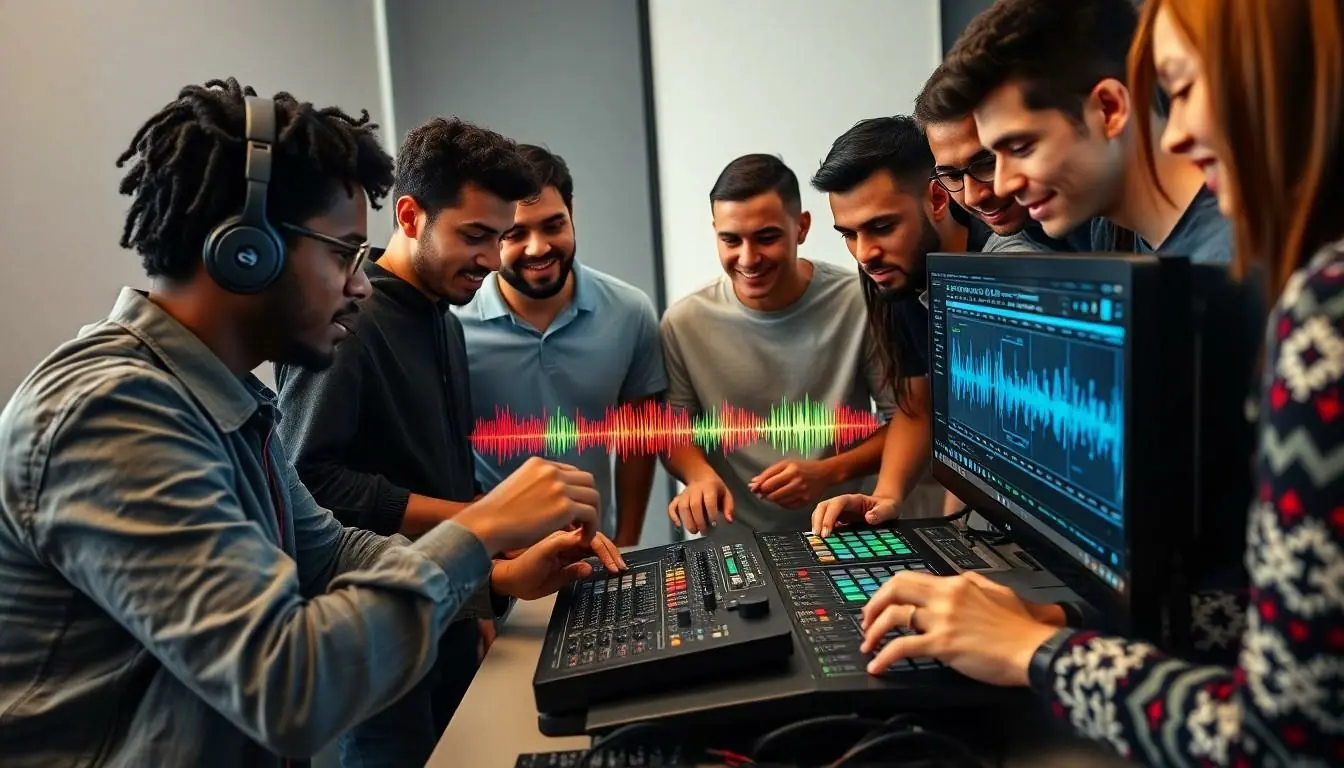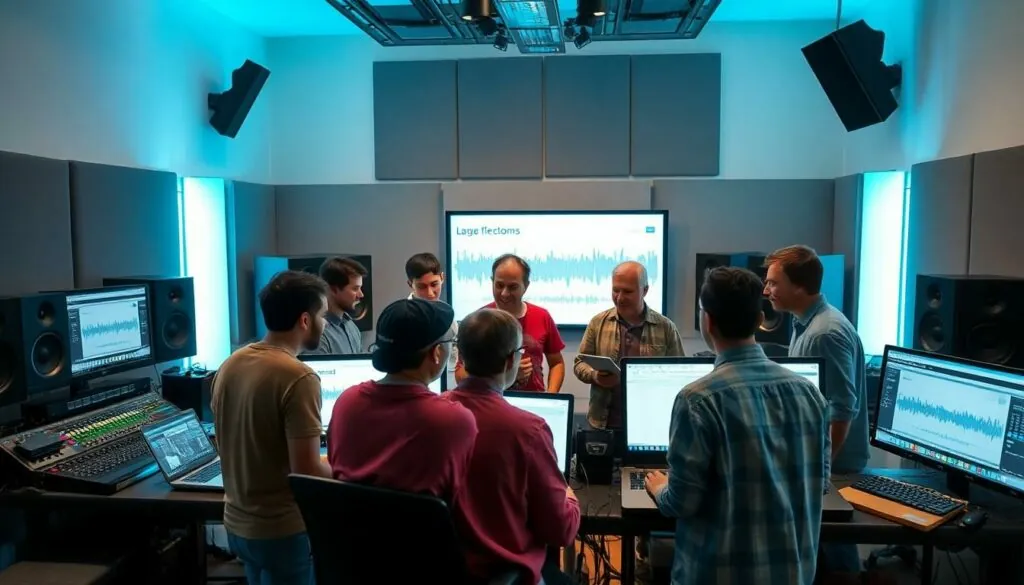Table of Contents
ToggleIn a world where everyone’s trying to outdo each other with the latest tech gadgets, open audio technology is the unsung hero of sound innovation. Imagine a universe where creativity flows freely, and sound engineers can collaborate without the pesky chains of proprietary software holding them back. It’s like a jam session where everyone’s invited—no cover charge!
Open audio technology isn’t just about making music; it’s about revolutionizing how we interact with sound. From podcasts to immersive audio experiences, this tech empowers creators to experiment, innovate, and share their work with the world. So, whether you’re a seasoned pro or just someone who loves belting out tunes in the shower, open audio technology is here to turn up the volume on your creative journey.
Overview of Open Audio Technology
Open audio technology empowers creators across multiple domains, revolutionizing how sound is produced and shared. This technology encompasses various frameworks, tools, and platforms, allowing individuals to access and modify audio software freely. Sound engineers leverage open audio tools to push the boundaries of creativity, enabling innovative projects that span genres and formats.
Collaboration flourishes within the open audio community, as users share their experiences and techniques via forums and online platforms. By focusing on open standards, this technology eliminates barriers associated with proprietary software, thus fostering an inclusive environment. Open audio technology is not limited to music; it significantly impacts podcast production, sound design for films, and interactive media.
Expanding opportunities is a key advantage of open audio technology, as creators can incorporate third-party plugins and tools to enhance their projects. A robust ecosystem of tools supports this diversity, with options like Audacity, Ardour, and LMMS providing powerful audio editing capabilities. This variety encourages experimentation and personalized approaches to sound creation.
Accessibility plays a critical role in the growth of open audio technology. Free or low-cost software alternatives allow individuals from various backgrounds to explore their audio interests without financial barriers. Community-driven support ensures users receive assistance and resources for troubleshooting and learning. The flexibility of this technology promotes continuous development, as updates and new features rely on community contributions.
Underpinning the success of open audio technology is its ability to inspire fresh perspectives in sound production. Creators take advantage of the collective knowledge shared within the community, fostering an environment where innovation thrives. Ultimately, this technology serves as a catalyst for creativity, enabling individuals to push the limits of their audio projects.
Key Features of Open Audio Technology

Open audio technology offers remarkable features that empower creators in diverse audio fields.
Accessibility
Accessibility stands out as a primary benefit of open audio technology. Individuals from various backgrounds can explore audio creation without financial constraints. Free or low-cost software alternatives minimize barriers, allowing novice and experienced users to experiment with sound design. Platforms like Audacity and LMMS serve as gateways for those interested in sound production. Community-driven initiatives provide valuable resources for troubleshooting, questions, and learning opportunities. By prioritizing accessibility, open audio technology enables a broader demographic to engage in audio experimentation.
Customizability
Customizability serves as another defining feature of open audio technology. Users can modify software to suit their specific needs and preferences. This flexibility encourages creative exploration and allows sound engineers to enhance their projects uniquely. The integration of third-party plugins expands options significantly, enabling personalized workflows. Tools such as Ardour come with extensive settings and configurations, catering to diverse audio production styles. Through customization, creators can push their projects further and realize innovative sound experiences.
Benefits of Open Audio Technology
Open audio technology provides numerous advantages that enhance creativity and collaboration within the audio community. Key benefits include collaboration and innovation as well as cost-effectiveness.
Collaboration and Innovation
Collaboration flourishes in the open audio technology landscape. Creators share insights and techniques across various platforms, fostering a supportive community. This environment encourages idea exchange and feedback, leading to innovative projects that push boundaries. In this context, collective intelligence drives the development of new tools and methodologies. The integration of diverse perspectives results in unique audio creations, making experimentation a core aspect of the process. Through collective collaboration, creators redefine sound production and explore uncharted territories in audio design.
Cost-Effectiveness
Cost-effectiveness stands out among the primary benefits of open audio technology. Individuals can access high-quality audio tools without significant financial investment. Free or low-cost options like Audacity and LMMS empower users from various backgrounds to dive into audio creation. Financial constraints often limit opportunities, but these accessible platforms ensure everyone can participate. This cost advantage also allows flexibility in exploring multiple tools, encouraging users to find the best fit for their needs. As a result, creators can focus on their craft rather than worry about software expenses, enhancing production quality and creativity.
Popular Open Audio Technologies
Open audio technologies play a vital role in the evolution of sound production, encompassing both software and hardware solutions.
Open Source Software
Open source software forms the backbone of many audio tools. Audacity is a widely-used digital audio editor that enables users to record and edit sound efficiently. Ardour offers a powerful digital audio workstation for professionals, providing advanced features for recording and mixing. LMMS caters to music creators with its user-friendly interface and extensive sound library. Each of these tools allows customization, giving users freedom to adapt them as needed. Collaborations flourish within the open source community, with users regularly sharing plugins and enhancements. Access to such software lowers barriers, welcoming diverse creators to engage in audio production without significant financial burdens.
Hardware Solutions
Hardware solutions complement open audio software, enhancing the overall sound experience. MIDI controllers enable creative input, allowing musicians to manipulate sounds easily. Audio interfaces convert analog signals into digital for clear recording and playback. These tools often integrate seamlessly with open source software to maximize productivity. Various manufacturers produce equipment designed specifically for compatibility with open audio technology. Many audio enthusiasts opt for open hardware options to maintain flexibility and customization in their setup. Collaborations between hardware developers and software communities foster innovative solutions that cater to evolving audio needs.
Challenges in Open Audio Technology
Limited funding presents a significant obstacle for developing and refining open audio technologies. Many projects rely on community donations and volunteer contributions, which do not guarantee sustained progress or updates. Technical expertise varies within the community, leading to inconsistencies in software quality and user experience.
Intellectual property concerns arise with open audio technology, as collaboration and sharing may potentially infringe on copyright laws. Creators might hesitate to use or adapt existing work due to fears of legal repercussions. Compatibility issues challenge users as various software and hardware platforms may not always function seamlessly together.
Another challenge involves user adoption. Some individuals may prefer proprietary solutions due to perceived reliability or ease of use, limiting the potential audience for open audio tools. Documentation and support resources can also be inadequate, leaving users without guidance when attempting to navigate complex functionalities.
Security vulnerabilities can occur, especially when open-source tools allow modifications. Without proper oversight, malicious alterations may introduce risks. Community engagement is vital, yet maintaining a vibrant dialogue among users and developers can be difficult, especially as membership fluctuates.
Market competition poses another hurdle for open audio technology. As proprietary software often dominates market share, open solutions must demonstrate clear advantages to attract users. Innovation frequently hinges on continuous development, and without sufficient contributors, progress may stagnate.
Overall, addressing these challenges requires collaborative efforts, ongoing community support, and strategic initiatives to enhance the landscape of open audio technology.
Open audio technology represents a transformative force in the audio landscape. By breaking down barriers and promoting accessibility, it invites creators from all backgrounds to explore their passions. The collaborative spirit within the community not only fosters innovation but also ensures that users can continuously evolve their craft.
As the ecosystem of tools and platforms grows, so do the opportunities for experimentation and personalization. While challenges remain, the commitment to open standards and community support paves the way for a vibrant future in sound production. Embracing open audio technology is more than a choice; it’s a pathway to limitless creative potential.

